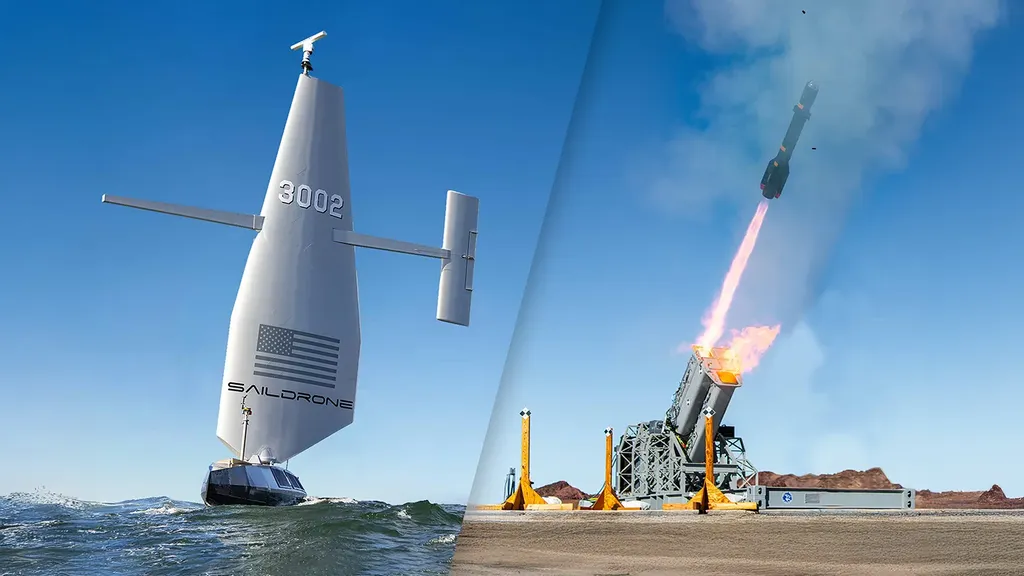Lockheed Martin has announced a $50 million investment in Saildrone, a leading developer of maritime autonomous systems, to advance the United States Navy’s unmanned surface vehicle (USV) capabilities. The partnership aims to integrate Lockheed Martin’s combat-proven defence technologies with Saildrone’s operationally tested USV platforms, with live-fire demonstrations expected to take place in 2026.
This collaboration will focus on delivering commercially available unmanned surface vehicles equipped with advanced and lethal systems. Work on the project is set to begin immediately, adopting an open-architecture approach with secure command and control features. This will include integrating Lockheed Martin’s JAGM Quad Launcher (JQL) system onto the Saildrone Surveyor platform.
According to information shared by the companies, the relationship combines the world’s most trusted defence technology with one of the most capable autonomous maritime systems currently in operation. The integration is expected to support the U.S. Navy’s ambitions in areas such as fleet defence, undersea surveillance, reconnaissance, and offensive operations.
Saildrone is also developing larger USV models capable of carrying significantly heavier payloads and systems, including Lockheed Martin’s Mk 70 Vertical Launch System (VLS) and thin-line towed arrays for undersea detection. Since 2013, the company’s USVs have carried out complex missions across remote ocean regions. The U.S. Navy first deployed Saildrone’s systems in 2021, and they remain operational globally, supporting naval missions throughout the year.
Under the agreement, Saildrone will continue to oversee all shipbuilding responsibilities, while Lockheed Martin will act as the lead mission integrator. The defence company stated that the investment aims to speed up and reduce risks in deploying new autonomous defence technologies, while also improving its existing systems for fully autonomous operations. The initiative is also expected to support U.S. shipbuilding and defence manufacturing.
Production of Saildrone’s larger USVs will create jobs at Austal USA on the Gulf Coast, with potential to expand across other American shipyards as the programme scales up. The companies stated that their primary focus is on integrating ready and proven capabilities to ensure the Navy’s warfighters gain access to advanced unmanned systems as quickly as possible.
This partnership underscores a broader trend in the defence sector, where collaboration between established defence contractors and innovative startups is accelerating the development of next-generation military technologies. By leveraging Saildrone’s expertise in autonomous maritime systems and Lockheed Martin’s proven combat technologies, the U.S. Navy stands to gain a significant advantage in unmanned surface operations.
The move also highlights the growing importance of unmanned systems in modern naval warfare, as nations seek to enhance their capabilities in surveillance, reconnaissance, and offensive operations without putting personnel at risk. As the U.S. Navy continues to invest in autonomous technologies, this partnership could set a precedent for future collaborations in the defence industry.
Moreover, the integration of open-architecture systems and secure command and control features reflects a strategic shift towards modular and adaptable defence solutions. This approach not only enhances operational flexibility but also ensures that the Navy can quickly adapt to emerging threats and technological advancements.
In summary, Lockheed Martin’s investment in Saildrone represents a significant step forward in the development of advanced unmanned surface vehicles for the U.S. Navy. The partnership is poised to drive innovation, create jobs, and strengthen the nation’s defence capabilities in the maritime domain. As the programme progresses, it will be crucial to monitor the outcomes of the live-fire demonstrations and the broader impact on the defence industry.

